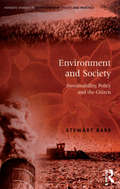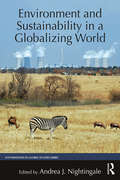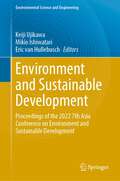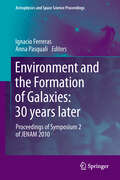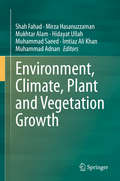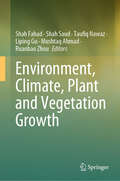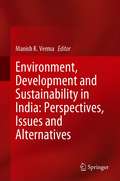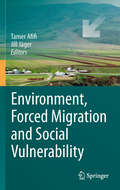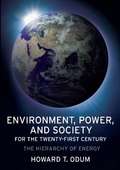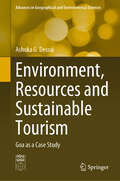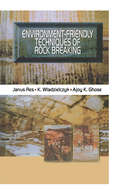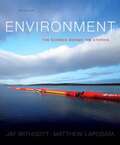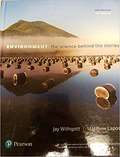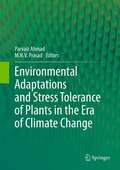- Table View
- List View
Environment and Society: A Critical Introduction (Critical Introductions to Geography #13)
by Paul Robbins Sarah A. Moore John G. HintzA comprehensive yet accessible introduction to the conceptual tools used to explore real-world environmental problems Environment and Society: A Critical Introduction, Third Edition demonstrates how theoretical approaches such as environmental ethics, political economy, and social construction work as conceptual tools to identify and clarify contemporary environmental issues. Assuming no background knowledge in the subject, this reader-friendly textbook uses clear language and engaging examples to first describe nine key conceptual tools, and then apply them to a variety of familiar objects—from bottled water and French fries to trees, wolves, and carbon dioxide. Throughout the text, highly accessible chapters provide insight into the relationship between the environment and present-day society. Divided into two parts, the text begins by explaining major theoretical approaches for interpreting the environment-society relationship and discussing different perspectives about environmental problems. Part II examines a series of objects, each viewed through a sample of the theoretical tools from Part I, helping readers think critically about critical environmental topics such as deforestation, climate change, the global water supply, and hazardous e-waste. This fully revised third edition stresses a wider range of competing ways of thinking about environmental issues and features additional cases studies, up-to-date conceptual understandings, and new chapters in Part I on racializd environments and feminist approaches. Environment and Society: A Critical Introduction, Third Edition: Covers theoretical lenses such as commodities, environmental ethics, and risks and hazards, and applies them to touchstone environment-society objects like wolves, tuna, trees, and carbon dioxide Uses a conversational narrative to explain key historical events, topical issues and policies, and scientific concepts Features substantial revisions and updates, including new chapters on feminism and race, and improved maps and illustrations Includes a wealth of in-book and online resources, including exercises and boxed discussions, chapter summaries, review questions, references, suggested readings, an online test bank, and internet links Provides additional instructor support such as suggested teaching models, full-color PowerPoint slides, and supplementary teaching material Retaining the innovative approach of its predecessors, Environment and Society: A Critical Introduction, Third Edition remains the ideal textbook for courses in environmental issues, environmental science, and nature and society theory.
Environment and Society: Concepts and Challenges (Palgrave Studies in Environmental Sociology and Policy)
by Debra J. Davidson Magnus BoströmThis book offers a critical analysis of core concepts that have influenced contemporary conversations about environment-society relations in academic, political, and civil circles. Considering these conceptualizations are currently shaping responses to environmental crises in fundamental ways, critical reflections on concepts such as the Anthropocene, metabolism, risk, resilience, environmental governance, environmental justice and others, are well-warranted. Contributors to this volume, working across a multitude of areas within environmental social science, scrutinize underlying worldviews and assumptions, asking a common set of key questions: What are the different concepts able to explain? How do they take into account society-environment relations? What social, cultural, or geo-political biases and blinders are inherent? What actions or practices do the concepts inspire? The transdisciplinary engagement and reflexivity regarding concepts of environment-society relations represented in these chapters is needed in all spheres of society—in academia, policy and practice—not the least to confront current tendencies of anti-reflexivity and denialism.
Environment and Society: Sustainability, Policy and the Citizen (Routledge Studies in Environmental Policy and Practice)
by Stewart BarrEnvironment and Society explores ways to promote the behavioural shifts necessary for creating a 'sustainable society'. Through a critical approach to the links between sustainability, policy and citizen engagement, the book argues that sustainability policy needs to move towards a positive perspective, utilizing the well-known techniques of segmentation and social marketing. Such 'mainstreaming' of sustainable lifestyles is likely to be the only effective means of engaging the majority of citizens in the environmental debate, given the major influence of the consumer society on individual aspirations and beliefs. Comprised of three substantive elements, Environment and Society explores the context for behaviour change policy, the approaches adopted by politicians and academic researchers, and the application of such approaches using empirical data from two major research projects. The book is richly illustrated using both theoretical and empirical data and provides an excellent companion to all researchers interested in sustainable lifestyles.
Environment and Sustainability in a Globalizing World (Foundations in Global Studies)
by Andrea J. NightingaleFrom the Foundations in Global Studies series, this student-friendly text follows a two-pronged approach to help readers understand the globalizing processes relating to environment and sustainability, which are examined in a range of disciplines, including environmental studies, geography, global studies, political science, international affairs, comparative politics, and other disciplines. First, it presents foundational material that gives students the conceptual underpinnings required for rigorous analysis. Following the Introduction and Overview, Part One presents a brief historical overview of the concerns revolving around environmental sustainability in the modern era. The text then covers key concepts and theoretical constructs that define the global context for sustainable environmental practices, such as the key thinkers and theories pertaining to sustainable environmental practice, and the key international agencies and treaties involved in global discussions. The first part then explores the various models and ways to measure sustainability, the range of environmental domains at play in the sustainability dialogue, and the controversies surrounding them. Part Two employs case studies to examine theory and practice at work in particular situations. The case studies have been selected with an eye toward comprehensiveness of coverage across disciplines and across regions.
Environment and Sustainable Development: Proceedings of the 2021 6th Asia Conference on Environment and Sustainable Development (Environmental Science and Engineering)
by Mikio Ishiwatari Keiji Ujikawa Eric Van HullebuschThis book collects the latest advances, innovations, and applications in the field of environmental science and sustainable development, which were presented by scholars and researchers at the 2021 6th Asia Conference on Environment and Sustainable Development, held in Phuket, Thailand, November 6–8, 2021. The book covers highly diverse topics, including environmental dynamics, global environmental change and ecosystems management, environmental restoration and ecological engineering, water treatment and reclamation, environmental sustainability, health and the environment, wastewater and sludge treatment, solid waste management, air pollution and control. The contributions, which were selected in a rigorous international peer-review process, highlight numerous exciting ideas that will spur novel research directions and foster multidisciplinary collaborations.
Environment and Sustainable Development: Proceedings of the 2022 7th Asia Conference on Environment and Sustainable Development (Environmental Science and Engineering)
by Mikio Ishiwatari Keiji Ujikawa Eric Van HullebuschThis book presents selected papers from the 2022 7th Asia Conference on Environment and Sustainable Development, which was held in Kyoto, Japan, November 4–6, 2022. The event was co-sponsored by the International Network for Environmental and Humanitarian Cooperation, and technically supported by Yokohama National University and the National Institute for Environmental Studies, Japan. The book focuses on environmental restoration and ecological engineering, global environmental change and ecosystems management, environmental dynamics, wastewater and sludge treatment, air pollution and control, and environmental sustainability. The volume is a valuable resource for those in both academia and industry.
Environment and Sustainable Development: Proceedings of the 2023 8th Asia Conference on Environment and Sustainable Development (Environmental Science and Engineering)
by Mikio Ishiwatari Keiji Ujikawa Eric Van HullebuschThis book is a collection of selected, peer-reviewed papers presented at the 2023 8th Asia Conference on Environment and Sustainable Development (ACESD), held in Sapporo, Japan, November 3–5, 2023. The ACESD is held annually to provide a forum for researchers, practitioners, and professionals from industries, academia, and governments to discuss research, development, and professional practice in environmental and sustainable development. The book covers diverse topics, including environmental dynamics, global environmental change and ecosystems management, environmental restoration and ecological engineering, water treatment and reclamation, solid waste management, environmental sustainability, and air pollution and control. The book highlights numerous innovative ideas that will spur novel research directions and is a valuable resource for researchers and professionals working in these fields.
Environment and the City (Routledge Introductions to Environment: Environment and Society Texts)
by Clive George Joe Ravetz Joe Howe Peter W. RobertsFor the first time at the beginning of the twenty-first century, urban dwellers outnumber rural residents and this trend is set to continue. Consequently one of the most pressing issues of our time is how to square the social and economic development of cities with their environmental limits and those of the wider environment. The theme of the environment and city is topical at every level, from the politics of global trade to local community networks. Environment and the City looks at the evolution of cities in the developed and the developing world and the implications for resource consumption and environmental impacts. It takes a cross-cutting approach with new thinking on multiple geographies – the configuration of networks, exclusion, consumption, risk and ecological footprint. Urban environmental themes and their related social, economic and political agendas are outlined. In turn the environmental impacts and environmental agendas relating to key sectors of the urban economy are discussed. The global context to such issues is then explored before the practical tools and methods of urban environmental management are investigated. The theme of the sustainable city emerges from this – not so much as a standard menu, but as a learning process between all sections of society. This book, a valuable resource, provides a concise, accessible route map for all students interested in the environmental issues emanating from our urban society. Written to aid student understanding, the easily navigable text features boxed practical examples, discussion points, signposts to reading and websites, and a glossary.
Environment and the Formation of Galaxies: 30 years later
by Ignacio Ferreras Anna PasqualiThe publication of the morphology - density relation by Alan Dressler in 1980 brought into the limelight the role played by environment in the formation and evolution of galaxies. The symposium Environment and the Formation of Galaxies: 30 years later, was organised with the purpose of establishing the environmental impact on the evolution of galaxies and its dependence on look-back time. Special emphasis was placed on the physical mechanisms that are responsible for transforming galaxies once they are accreted by a group or a cluster, including the observable imprint left in the galaxy HI distribution. Other major topics of the symposium were the environmental dependence of galaxy properties at z >= 1 and the implementation of environmental effects in cosmological models of galaxy formation and evolution. This book presents the edited proceedings of this stimulating meeting.
Environment as a Weapon: Geographies, Histories and Literature (Historical Geography and Geosciences)
by Charles TravisEnvironment as a Weapon considers how the confluence of war and nature from the time of the Agricultural Revolution (10,000 BCE) to our present day has been represented in works of history, geography, and literature. In the Epic of Gilgamesh, the Torah and Greco-Roman myths, warfare is a trope commensurate with environmental disasters, extreme climate, and plague. In the medieval age myths the Táin, and Beowulf environments become allies and enemies. The equestrian steppeland as foundation of Genghis Khan’s and his heirs Pax Mongolica is chronicled in The Secret History of the Mongols and The Travels of Marco Polo. The West African Griot legend of Sundiata and the Little Ice Age wreck of the Spanish Armada in 1588 speak to oceanic and atmospheric dimensions of warfare. American Revolution political pamphlets, poetry, diaries and weather logs, reflect the severe weather and terrain deployed by George Washington’s early campaigns in the war of independence. Napoleon’s midwifing of Total War is captured in Mary Shelley’s Frankenstein, Leo Tolstoy’s War and Peace, and Charles Minard’s Carte figurative carto-graph of the disastrous 1812 French invasion of Russia. The U.S. Civil War and the organic-industrial assembles of its battles, arguably the first Anthropocene War, is parsed by the clarifying poetry of Emily Dickinson. Geopolitik and geo-hazards of flood and fire feature in the Global War works of Samuel Beckett, Kurt Vonnegut and James Dickey. The literature of Vietnamese and American war combat veterans reveals how North Vietnam’s Environmental Military Complex stalled the American Military Industrial Complex in the jungles, and R&R districts of southwestern Asia. Finally, he sci-fi of H.G. Wells’ World Set Free and David Mitchell’s Cloud-Atlas frame Oppenheimer’s sub-atomic deployments at Hiroshima and Nagasaki, James Lovelock’s ‘Gaia’ and U.S. military discourses situating global warming as a national security threat to America. Indeed, Environment and War ironically resonates with U.N. Secretary General António Guterres proclamation that “seventy-five years ago, the world emerged from a series of cataclysmic events: two successive world wars, genocide, a devastating influenza pandemic . . . Our founders gathered in San Francisco promising to save succeeding generations from the scourge of war.” Thus, a holistic approach to studying and mitigating the human and environmental impacts of warfare, must integrate methods from the arts, humanities and sciences. This involves understanding how the historical geographies of the Earth’s planetary systems have been perceived, deployed and emerged as agents of warfare, with the lithosphere, hydrosphere, cryosphere, biosphere and atmosphere transformed as arsenals against anthropogenic global warming. This book will be of interest to geographers, historians, and scholars in environmental studies, climate change, literature and military studies, as well as the broader environmental humanities.
Environment, Climate, Plant and Vegetation Growth
by Mirza Hasanuzzaman Shah Fahad Mukhtar Alam Hidayat Ullah Muhammad Saeed Imtiaz Ali Khan Muhammad AdnanThis book provides an up-to-date account of the current understanding of climate change and global warming related to environment, climate, plant and vegetation growth. The aim of this book is to provide a platform for scientists and academics world-wide to promote, share, and discuss various new issues and developments in the area of plant and vegetation growth related to climate change. Over the next decades, it is predicted that billions of people, particularly those in developing countries, face shortages of water and food and greater risks to health and life as a result of climate change. Concerted global action is needed to enable developing countries to adapt to the effects of climate change that are happening now and will worsen in the future. The book will also enhance the understanding on issues related to climate change, giving a clear indication of a looming global warming crisis. Addressing global climate change is a monumental battle that can only be fought by the leaders of tomorrow, but future leaders are molded through education and shaped by the leaders of today.
Environment, Climate, Plant and Vegetation Growth
by Mushtaq Ahmad Shah Fahad Shah Saud Taufiq Nawaz Liping Gu Ruanbao ZhouThe book provides currently available information on the changing climate and its impact on functional and adaptive features of plants. The book also cover cutting edge research on key determinants of plant growththat provides a direction towards execution of programs and practices that will assist resilience of crop production systems to the changing climate. This book will represent the updated scientific information regarding soil and plant productivity under changing climate which will be beneficial to academics and researchers working on climate change, agronomy, stress physiology, biotechnology. It provides an in-depth discussion on the latest techniques to enhance plant responses to new environmental conditions that can be directly applied on field.
Environment, Development and Sustainability in India: Perspectives, Issues and Alternatives
by Manish K. VermaThis book provides a comprehensive account of asymmetric linkage in the trilogy of environment, development and sustainability and its impact on society. It examines varied perspectives and issues of development related to environmental destruction and sustainability challenges. By examining the recent trends of development and recording the dilemmas which are creating ecological imbalances, it explores some alternative ways of development to achieve sustainability. Divided into three parts, it has a broad canvass. The first section examines critically the ‘perspectives’ on ecology, practice and ethics, rural development and man–forest interaction in the metropolis. ‘Issues’ of dams, river, agricultural distress, environmental migration, eco-tourism, ecological conservation and land acquisition are assessed in part second. ‘Alternative’ means of development is explored in part third by incorporating chapters on the constructed wetland, biofuels, subsistence economy, water and traditional knowledge practice. This interdisciplinary book is of immense significance to academicians, researchers, postgraduate and graduate-level students of social sciences and environmental studies; policymakers, development practitioners and NGOs working in the area of environment and development.
Environment, Energy and Applied Technology: Proceedings of the 2014 International Conference on Frontier of Energy and Environment Engineering (ICFEEE 2014), Taiwan, December 6-7, 2014
by Wen-Pei Sung Jimmy C. M. KaoThis proceedings volume brings together selected peer-reviewed papers presented at the 2014 International Conference on Frontier of Energy and Environment Engineering. Topics covered include energy efficiency and energy management, energy exploration and exploitation, power generation technologies, water pollution and protection, air pollution and
Environment, Forced Migration and Social Vulnerability
by Tamer Afifi Jill JägerThis book examines the linkages between environmental change and forced migration. This has been a headline topic during the past few years with predictions of "millions of refugees". It presents case studies from across the world of responses to climate change as well as other environmental changes and examines the role that environmental change plays among the other factors that lead to a decision to migrate.
Environment, Power, and Society for the Twenty-First Century: The Hierarchy of Energy
by Howard OdumHoward T. Odum possessed one of the most innovative minds of the twentieth century. He pioneered the fields of ecological engineering, ecological economics, and environmental accounting, working throughout his life to better understand the interrelationships of energy, environment, and society and their importance to the well-being of humanity and the planet.This volume is a major modernization of Odum's classic work on the significance of power and its role in society, bringing his approach and insight to a whole new generation of students and scholars. For this edition Odum refines his original theories and introduces two new measures: emergy and transformity. These concepts can be used to evaluate and compare systems and their transformation and use of resources by accounting for all the energies and materials that flow in and out and expressing them in equivalent ability to do work. Natural energies such as solar radiation and the cycling of water, carbon, nitrogen, and oxygen are diagrammed in terms of energy and emergy flow. Through this method Odum reveals the similarities between human economic and social systems and the ecosystems of the natural world. In the process, we discover that our survival and prosperity are regulated as much by the laws of energetics as are systems of the physical and chemical world.
Environment, Power, and Society for the Twenty-First Century: The Hierarchy of Energy
by Howard T. OdumHoward T. Odum possessed one of the most innovative minds of the twentieth century. He pioneered the fields of ecological engineering, ecological economics, and environmental accounting, working throughout his life to better understand the interrelationships of energy, environment, and society and their importance to the well-being of humanity and the planet. This volume is a major modernization of Odum's classic work on the significance of power and its role in society, bringing his approach and insight to a whole new generation of students and scholars. For this edition Odum refines his original theories and introduces two new measures: emergy and transformity. These concepts can be used to evaluate and compare systems and their transformation and use of resources by accounting for all the energies and materials that flow in and out and expressing them in equivalent ability to do work. Natural energies such as solar radiation and the cycling of water, carbon, nitrogen, and oxygen are diagrammed in terms of energy and emergy flow. Through this method Odum reveals the similarities between human economic and social systems and the ecosystems of the natural world. In the process, we discover that our survival and prosperity are regulated as much by the laws of energetics as are systems of the physical and chemical world.
Environment, Resources and Sustainable Tourism: Goa as a Case Study (Advances in Geographical and Environmental Sciences)
by Ashoka G. DessaiThis book suggests sustainable economy from the viewpoint of tourism fostering low carbon footprint. Focussed on conserving heritage, culture and endemic biota of a crucial biodiversity hotspot of the world, the book discusses the impact of a large population, fast-paced development and excessive consumption of earth resources by tourism in a developing economy. The book (i) assesses the impact of overexploitation of earth resources on environmental components such as air, water, land and people, (ii) examines the sustainability of tourism on the physical, economic and socio-cultural environment including human lifestyles, (iii) presents the potential of tourism in promoting sustainable development, poverty alleviation and conservation of nature and (iv) formulates recommendations for tourism, fostering sustainable development in Goa, India. The book offers students, researchers, academics and professionals a comprehensive discourse integrating geological and societal perspectives on core issues. It generates critical thinking on the complex issue of sustainable tourism by providing in-depth perspective on peoples of different hues and their role in safeguarding the future of this unique region.
Environment-Friendly Techniques of Rock Breaking
by Ajoy K. Ghose Janus Res K. WladzielczykSignificant advances have been made in non-explosive rock breaking techniques in the past two decades. This monograph focuses specifically on environmental-friendly rock excavating using chemical, thermal, hydraulic, electric and hybrid systems. It presents a comprehensive overview of the theoretical concepts and state-of-the-art practical developments based on these emerging techniques.
Environment: The Science Behind The Stories
by Jay H. Withgott Matthew LaposataEnvironment: The Science behind the Stories, 5/e, continues to revolutionize the environmental science course with integrated central case studies and real-life stories that provide you with a tangible and engaging framework for understanding science. The newly revised Fifth Edition offers a highly effective integration between text and media to emphasize scientific literacy and data analysis skills and encourages you to think critically about environmental issues.
Environment: The Science Behind the Stories
by Scott R. Brennan Jay Withgott"Environment: The Science Behind the Stories" is an introductory textbook that uses case studies and real data to demonstrate the role of science in identifying and solving pressing environmental problems. The book integrates case studies into the body of the text to provide a contextual framework for the science readers are learning. With only 22 chapters, this book avoids the encyclopedic approach of other textbooks on the market. A panoramic view of environmental science and issues, including the important policy, economic, and ethical issues behind the scientific ones. For college instructors, students, and anyone interested in environmental science and issues.
Environment: The Science Behind the Stories
by Jay Withgott Matthew LaposataEnvironment: The Science Behind the Stories 6th Edition, AP Edition.
Environment: The Science Behind the Stories (Second Edition)
by Scott Brennan Jay Withgott"Environment: The Science Behind the Stories" is an introductory textbook that uses case studies and real data to demonstrate the role of science in identifying and solving pressing environmental problems. The book integrates case studies into the body of the text to provide a contextual framework for the science readers are learning. With only 22 chapters, this book avoids the encyclopedic approach of other textbooks on the market. A panoramic view of environmental science and issues, including the important policy, economic, and ethical issues behind the scientific ones. For college instructors, students, and anyone interested in environmental science and issues.
Environment: The Science Behind the Stories AP Edition
by Scott Brennan Jay Withgott"Environment: The Science behind the Stories" continues to revolutionize the environmental science course with integrated central case studies and real-life stories that provide you with a tangible and engaging framework for understanding science. The newly revised Fifth Edition offers a highly effective integration between text and media to emphasize scientific literacy and data analysis skills and encourages you to think critically about environmental issues.
Environmental Adaptations and Stress Tolerance of Plants in the Era of Climate Change
by Parvaiz Ahmad M.N.V. PrasadClimate change is a complex phenomenon with a wide range of impacts on the environment. Biotic and abiotic stress are a result of climate change. Abiotic stress is caused by primary and secondary stresses which are an impediment to plant productivity. Prolonged exposure to these stresses results in altered metabolism and damage to biomolecules. Plants evolve defense mechanisms to withstand these stresses, e.g. synthesis of osmolytes, osmoprotectants, and antioxidants. Stress responsive genes and gene products including expressed proteins are implicated in conferring tolerance to the plant. This volume will provide the reader with a wide spectrum of information, including vital references. It also provides information as to how phytoconstituents, hormones and plant associated microbes help the plants to tolerate the stress. This volume also highlights the use of plant resources for ameliorating soil contaminants such as heavy metals. Dr. Parvaiz is Assistant professor in Botany at A.S. College, Srinagar, Jammu and Kashmir, India. He has completed his post-graduation in Botany in 2000 from Jamia Hamdard New Delhi India. After his Ph.D from the Indian Institute of Technology (IIT) Delhi, India in 2007 he joined the International Centre for Genetic Engineering and Biotechnology, New Delhi. He has published more than 20 research papers in peer reviewed journals and 4 book chapters. He has also edited a volume which is in press with Studium Press Pvt. India Ltd., New Delhi, India. Dr. Parvaiz is actively engaged in studying the molecular and physio-biochemical responses of different plants (mulberry, pea, Indian mustard) under environmental stress. Prof. M.N.V. Prasad is a Professor in the Department of Plant Sciences at the University of Hyderabad, India. He received B.Sc. (1973) and M.Sc. (1975) degrees from Andhra University, India, and the Ph.D. degree (1979) in botany from the University of Lucknow, India. Prasad had published 216 articles in peer reviewed journals and 82 book chapters and conference proceedings in the broad area of environmental botany and heavy metal stress in plants. He is the author, co-author, editor, or co-editor for eight books. He is the recipient of Pitamber Pant national Environment Fellowship of 2007 awarded by the Ministry of Environment and Forests, Government of India.


